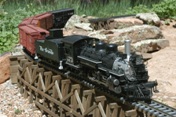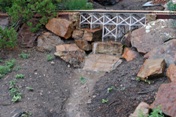|
Code 250, Code 332, Live Steam, Battery, DCC, Track power, Air Wire, Aluminum, Brass, Nickel Silver, Hand laid track, 1:24, 1:22.5, 1:20.3, the East Mountains have it all. 9-27-06
The East Mountain Boys opened up their Railroads for a tour and we got it all. I have never seen such variety. If you don't know what any of the above Jargon means, don't worry. You certainly get an education when you see those four very different railroads. They have different terrain, layouts, control, colors, the only thing they share is 45mm track width. If you missed the tour take it here. What is Code 250 & 332? Furman & Beck provided the photos. |
||||||||
|
||||||||

